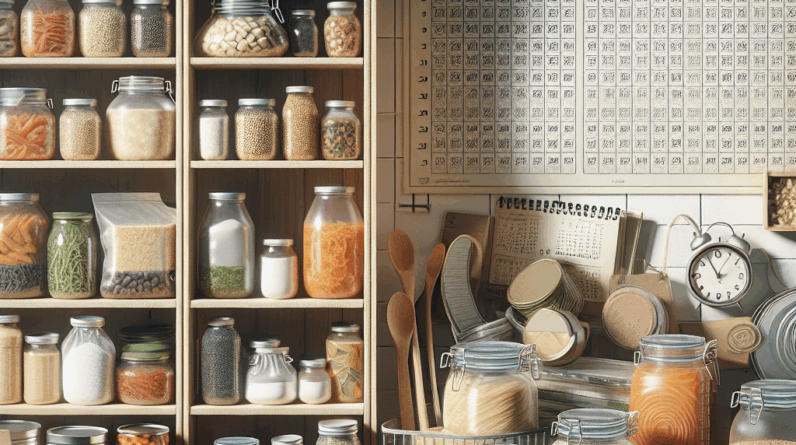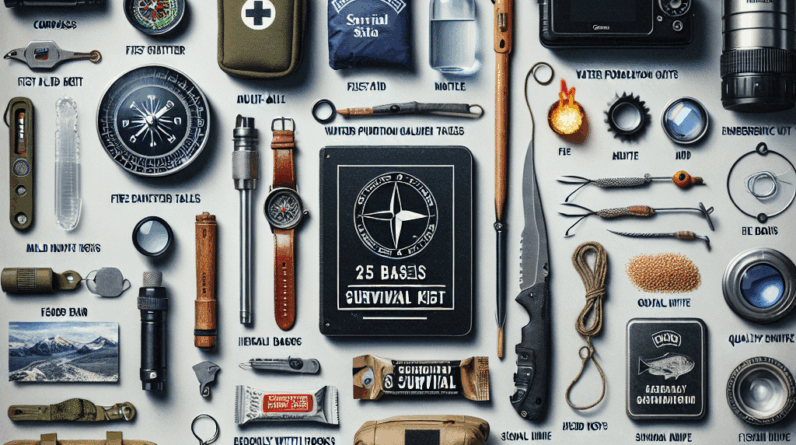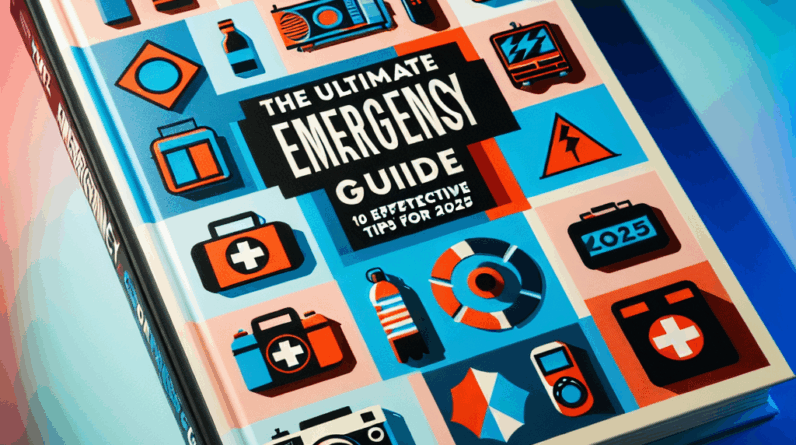Creating a comprehensive emergency preparedness plan is not just a precaution—it’s a necessity. Whether it’s natural disasters or unexpected emergencies, having a plan can significantly increase your safety and comfort during stressful times. Let’s dive into the structured steps to ensure you and your loved ones are well-prepared for any situation.
Step 1: Assess Your Risks
# Understand Your Environment
When I began to consider emergency preparedness, I quickly realized the importance of being familiar with my surroundings. I evaluated the types of disasters most likely to occur in my area, such as earthquakes, floods, or wildfires. Recognizing the specific natural disasters your locality is prone to is crucial for crafting an effective emergency plan.
While it’s essential to be aware of major disasters, don’t overlook more frequent issues like power outages or civil unrest. Each risk will affect your life uniquely, requiring a customized approach to your emergency plan. Researching local emergency services and community resources is also vital, as it aligns your personal safety measures with broader support systems.
# Identify Your Vulnerabilities
I examined my personal circumstances to identify potential vulnerabilities. Depending on your situation, you may need to consider the needs of children, elderly relatives, or pets. Listing these vulnerabilities will guide you in preparing adequately for various scenarios.
Key considerations should include medical needs and transportation options, especially if driving isn’t feasible for you. Moreover, involving everyone in your household in training and planning can significantly enhance the robustness of your emergency response.
# Engage Your Community
The strength of community engagement can be immensely beneficial in emergency preparedness. Initiating neighborhood meetings can shed light on localized risks and collaborative preparation efforts. Sharing resources and emergency contact lists can transform your neighborhood into a resilient safety network.
Building strong community bonds not only boosts morale but also enhances mutual support during emergencies. Thus, knowing your neighbors and exchanging preparation strategies can be incredibly advantageous.
Step 2: Create a Checklist
# Essential Supplies
Putting together a comprehensive checklist was a transformative step in activating my preparedness plan. This list included essentials like food, water, first-aid kits, and flashlights. Regularly updating this checklist ensures that all supplies are current and functional—avoid the pitfall of discovering expired emergency food!
Include other items like batteries, a multi-tool, and hygiene products. Maintaining a basic hygiene kit is crucial and often underestimated in its importance during disasters.
# Evacuation Plans
Developing a reliable evacuation plan involved identifying safe exits from my home and establishing multiple escape routes. Posting a floor plan on the refrigerator helps everyone in the household familiarize themselves with these routes.
Designating a meeting spot outside your home where everyone can regroup post-evacuation reduces confusion and chaos during an actual emergency. Practicing this plan through drills ensures that everyone understands their role and allows for adjustments to be made proactively.
# Communication Strategies
Effective communication is paramount during emergencies. With the potential for cellular networks to be overwhelmed, having a list of essential contacts and considering offline communication methods is essential. Practicing leaving notes or establishing a family code word can improve safety during actual emergencies.
Stay informed by subscribing to local alerts and ensuring your family knows how to access updates when needed.
Step 3: Build a Support Network
# Connect with Local Resources
I actively sought out local emergency management agencies and community organizations to understand available resources better. These connections can offer additional training and support specific to your needs, from community drills to first aid workshops.
Don’t overlook online platforms like local Facebook groups or community boards, which can be a treasure trove of information and connections.
# Join a Preparedness Group
Joining a local preparedness group was incredibly enriching, providing motivation and fresh ideas for my emergency plan. These groups facilitate sharing of resources and experiences, helping you stay committed to regularly updating your preparedness measures.
Keep an open mind; you may discover valuable tips from others’ experiences that could be applicable to your situation.
# Practice Care and Support
Beyond physical resources, emotional support plays a critical role in a comprehensive support network. It’s comforting to know you have people who can help alleviate your concerns during emergencies.
Regular check-ins with friends, family, and neighbors not only strengthen community ties but also mentally prepare you for potential emergencies. It’s perfectly normal to discuss and express concerns about emergencies, which can lead to practical, reassuring solutions.
Step 4: Educate and Train
# Take Safety Courses
Enrolling in safety courses such as basic first aid, CPR, or disaster response has greatly empowered my emergency readiness. These courses, available through community centers or online, are worth the investment of time and effort.
Sharing this learning experience with family or neighbors encourages a collaborative and prepared community.
# Drill Regularly
After acquiring safety knowledge, practicing through regular drills ensures that everyone feels comfortable and prepared. Initial drills might be chaotic, but they reveal what adjustments are necessary for an effective emergency plan.
Make drills engaging yet serious to foster adherence and seriousness among participants. Post-drill debriefings are crucial for discussing successes and areas for improvement.
# Involve Everyone
Inclusive education about emergencies should involve all family members, including children and pets. For children, integrating games and relatable scenarios can make learning about safety measures engaging and impactful.
Pets also benefit from being included in training, ensuring they remain calm and responsive during emergencies.
Step 5: Review and Revise Your Plan
# Regular Updates
Life’s constant changes necessitate regular updates to your emergency plan. Set a routine, such as every six months, to review and adjust your plan as needed. This might include checking supply expirations, updating contact information, and revising evacuation routes.
Feedback from community interactions and drills can provide further insights, enhancing the relevance and effectiveness of your preparedness efforts.
# Incorporate New Information
Staying informed about the latest in emergency management can introduce new practices and insights into your plan. Engage with updated guidelines from authorities and incorporate relevant new information as it becomes available.
Continuous learning and networking open doors to resources that might previously have been overlooked, keeping your preparedness plan ahead of the curve.
# Practice Flexibility
Adaptability is crucial in emergency preparedness, as no plan is immune to the unpredictable nature of real-world events. Cultivating a flexible approach within your family can reduce stress and improve cooperation during actual emergencies.
Regular discussions about potential plan adjustments ensure everyone is prepared to adapt, highlighting the strength of your preparedness strategy.
Frequently Asked Questions
# 1. What is the first step to begin my emergency preparedness plan?
The initial step in crafting an emergency preparedness plan is to assess your risks. This involves understanding the specific threats your area faces, from natural disasters to more common emergencies.
# 2. How often should I update my emergency supplies?
It’s advisable to review your emergency supplies at least every six months to ensure they remain fresh and functional.
# 3. How can I involve my children in the emergency preparedness process?
Engaging children in emergency preparedness can be fun. Utilize games and scenarios that they can relate to, and encourage them to participate actively in discussions and planning.
# 4. What should I do if I don’t have a support network?
If you find yourself without a support network, reaching out to neighbors or joining local preparedness groups can be very beneficial. Online forums also offer access to a wealth of information and community support.
# 5. Why is it important to practice drills regularly?
Regular drills help familiarize everyone with the emergency plan, reducing anxiety and ensuring smoother execution in real emergencies. They also allow for the identification and rectification of any issues in your arrangements.




